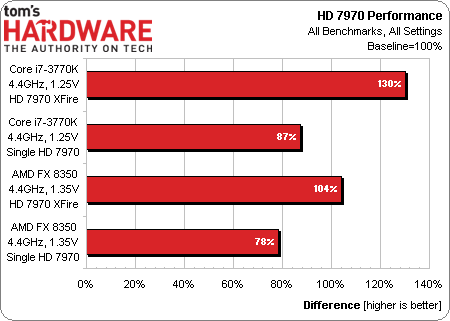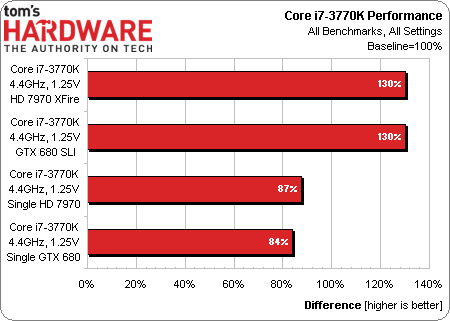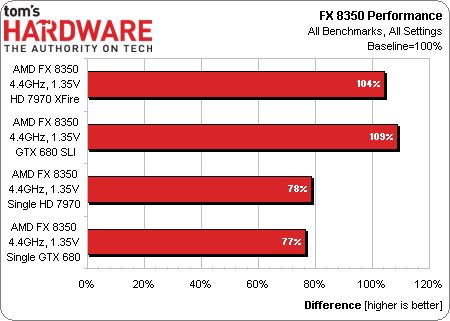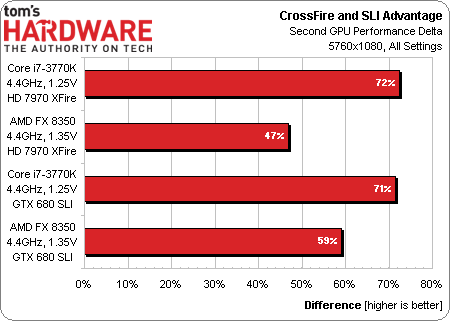CrossFire Versus SLI Scaling: Does AMD's FX Actually Favor GeForce?
We've heard it said before that AMD's GPUs are more platform-dependent than Nvidia's. So, what happens when you drop a Radeon and a GeForce into an FX-8350-based system? Does AMD's CPU get in the way of its GPU running as well as it possibly could?
CPU-To-GPU Performance Scaling
Much to the chagrin of my boss, I followed up a week of benchmarking with a few days of wading through data, trying to figure out the best way to present these results. We can, for example, consider the cards first.
We clearly see that the Core i7-3770K gets a bigger boost from two Radeon HD 7970s in CrossFire than AMD's FX-8350, but that could just be a general indication of lower CPU performance from the Vishera-based CPU. That is fair enough. The FX is a less expensive processor, so we're completely fine with it not performing as well.
SLI scales a little better than CrossFire on the Intel CPU, and the SLI-versus-CrossFire spread is even wider on the FX-8350-based configuration. We’re getting close to an answer.
Using the Core i7-3770K as a common factor, we find that AMD's Radeon HD 7970 slightly outperforms the GeForce GTX 680 in our test suite. Yet, slightly better scaling allows SLI to catch up to CrossFire.
Conversely, the FX-8350 appears to favor Nvidia's SLI technology over CrossFire. This is just another data point quantifying the potential validity of claims that AMD's cards are more limited on its own processors, and that Nvidia's graphics hardware is able to extract more performance from a top-end FX.
Intel takes an 11% lead over AMD when paired to a single Radeon HD 7970. That lead shrinks to only 9% when a single GeForce GTX 680 is used. Of course, this chart doesn’t make clear whether AMD is favoring the GeForce, or Intel is instead favoring the Radeon.
CrossFire boosts gaming performance on Intel's Core i7-3770K by 72%, but only manages to speed up frame rates on AMD's FX-8350 by 47%. The Vishera-based FX gets a far bigger kick from SLI.
Get Tom's Hardware's best news and in-depth reviews, straight to your inbox.
Current page: CPU-To-GPU Performance Scaling
Prev Page Power And Efficiency Next Page How Does FX Treat Your Graphics Card?-
Crashman BigMack70This article was a good laugh... I sincerely hope nobody is throwing $800+ worth of graphics muscle onto an FX series CPU.I think AMD is just trolling gamers with their CPUs. Although they're definitely catching up to Intel while Intel just sorta sits there and doesn't do anything after declaring ultimate victory with Sandy Bridge.The great thing about AMD is that its chipsets have a lot of PCIe lanes. That should make them great for multi-way graphics. The problem is, the more cards you add the worse the CPU looks. I can see someone doing 3-way SLI on a new 990FX board if they already had a few older/slower cards laying around.Arfisy Perdanawhat a pity for amd processor. So terribleNot terrible, AMD charges appropriately less for its slower CPU. It's no big deal, unless you're trying to push some high-end AMD graphics cards.Reply
Nobody remembers that at the time AMD bought ATI, they already had a business partnership with Nvidia on the co-marketing of 650A chipsets (AMD Business Platform) Also at the time AMD bought ATI, ATI already had a business partnership with Intel to develop the RD600 as a replacement for the 975X. AMD's purchase left both Nvidia and Intel stranded, as it took Intel more than a year to develop a replacement for the abandoned RD600.
-
Crashman BigMack70Meh... they're PCI-e 2.0 lanes so they need twice as many to equal the PCI-e 3.0 lanes on Z77Depends on the cards you're using. 3-way at x8/x8/x4? Tom's Hardware did an article on how bad PCIe 2.0 x4 performed, so if you're carrying over a set of PCIe 2.0 cards from a previous system, well, I refer to the same comment that you referenced.Reply -
Thanks for the article it was great.Reply
Amd is actually doing fine with their products especially with their GPUs.
Why so much hate on their CPUs i will never understand.They are cheaper aren't they?
-
CaptainTom I'm going to be honest, this article didn't prove anything for these reasons:Reply
-The i7 is stronger so of course it scaled better.
-The 7970 is on average a stronger card than the 680, so of course it needs a little extra CPU power.
-The differences overall were very little anyways besides the obvious things like Skyrim preferring Intel. -
smeezekitty CaptainTomI'm going to be honest, this article didn't prove anything for these reasons:-The i7 is stronger so of course it scaled better.-The 7970 is on average a stronger card than the 680, so of course it needs a little extra CPU power.-The differences overall were very little anyways besides the obvious things like Skyrim preferring Intel.You hit the nail right on the head.Reply -
ohyouknow CaptainTomI'm going to be honest, this article didn't prove anything for these reasons:-The i7 is stronger so of course it scaled better.-The 7970 is on average a stronger card than the 680, so of course it needs a little extra CPU power.-The differences overall were very little anyways besides the obvious things like Skyrim preferring Intel.Reply
Truth. Didn't really see anything other than the same games that show the FX falling behind did the same thing in this test as it would with anything involving Skyrim and so forth. -
billcat479 I wish I could have seen a lets say better test. I'm not great at knowing which games to pick and one thing I would have liked to see is games that are able to use more than one core of the cpu.Reply
I know when the AMD came out with the new FX it's single threading was still not up to intel's standards but in many of the tests that used more core's the AMD could actually keep up with Intel's cpus. Not as good all the time but it's very very easy to make these AMD cpu's look bad, just run a single threaded and/or older game at them and presto.
I would have liked to see how the video card would play into this, if AMD's running more optimized software would it's crossfire come out better as well as it's overall effect in games that make use of this.
I mean how long have we had more than one cpu core running now?
And I know it's taken the software people to come up to speed but the game board is changing and they are starting more and more to use more than one core so do you think this would be important to check out as well. And just maybe see some new data from how the AMD can use video cards if it's running software it was really designed for?
We can play this Intel single thread line till hell freezes over and we all know there will not be any surprises as long as we do.
And we also have seen a shift if low cost game setups start to favor AMD's older cpus because there is more software that can run on more core's? So lets start to even out the playing field a bit here ok?






